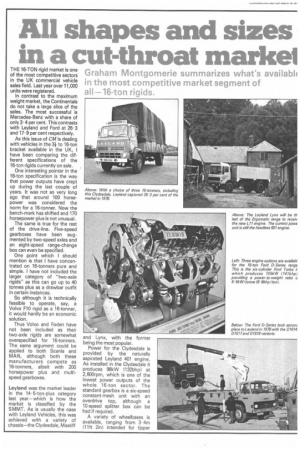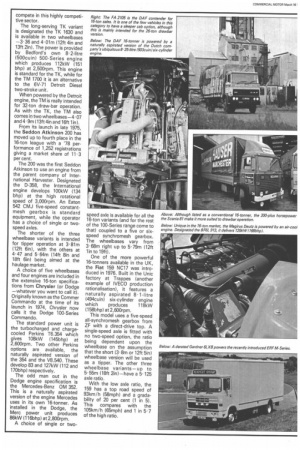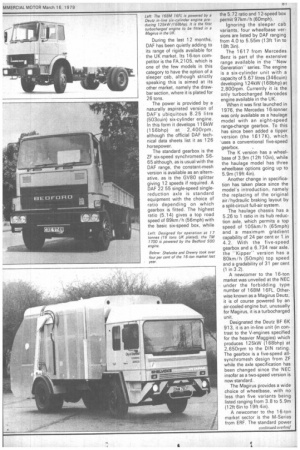All shapes and sizes
Page 80

Page 81

Page 82

Page 83

Page 84

If you've noticed an error in this article please click here to report it so we can fix it.
in a cut-throat markei
Graham Montgomerie summarizes what's availabh in the most competitive market segment of all-16-ton rigids.
THE 16-TON rigid market is one of the most competitive sectors in the UK commercial vehicle sales field. Last year over 11,000 units were registered.
In contrast to the maximum weight market, the Continentals do not take a large slice of the sales. The most successful is Mercedes-Benz with a share of only 3. 4 per cent. This contrasts with Leyland and Ford at 26.3 and 17. 9 per cent respectively.
As this issue of CM is dealing with vehicles in the al to 16-ton bracket available in the UK, I have been comparing the different specifications of the 16-ton rigids currently on sale.
One interesting pointer in the 16-ton specification is the way that power outputs have crept up during the last couple of years. It was not so very long ago that around 100 horsepower was considered the norm for a 16-tonner. Now the bench-mark has shifted and 170 horsepower plus is not unusual.
The same is true for the rest of the drive-line. Five-speed gearboxes have been augmented by two-speed axles and an eight-speed range-change box can even be specified.
One point which I should mention is that I have concentrated on 16-tonners pure and simple. I have not included the larger category of "two-axle rigids" as this can go up to 40 tonnes plus as a drawbar outfit in certain instances.
So although it is technically feasible to operate, say, a Volvo F10 rigid as a 16-tonner, it would hardly be an economic solution.
Thus Volvo and Foden have not been included as their two-axle rigids are somewhat overspecified for 16-tonners. The same argument could be applied to both Scania and MAN, although both these manufacturers compete as 16-tonners, albeit with 200 horsepower plus and multispeed gearboxes.
Leyland was the market leader in the 14 5-ton-plus category last year— which is how the market is classified by the SMMT. As is usually the case with Leyland Vehicles, this was achieved with a variety of chassis—the Clydesdale, Mastiff and Lynx, with the former being the most popular.
Power for the Clydesdale is provided by the naturally aspirated Leyland 401 engine. As installed in the Clydesdale it produces 98kW (132bhp) at 2,600rpm, which is one of the lowest power outputs of the whole 16-ton sector. The standard gearbox is a six-speed constant-mesh unit with an overdrive top, although a 10-speed splitter box can be had if required.
A variety of wheelbases is available, ranging from 3-4m (lift 2in) intended for tipper work right up to the longest haulage model at 58m (19ft).
The Leyland Lynx will be the last of the Ergomatic range to receive the new naturally aspirated L11 engine which was announced at the Birmingham motor show last year. The current Lynx, however, still retains the 501 engine which develops 128kW (172bhp) at 2,40Orpm.
No choice of gearbox is available—the standard fitment is a six-speed constant-mesh design with an overdrive top.
The performance of the Lynx on the road and up the hills obviously varies with axle ratio but as a guide, the 6-25 ratio
gives a top speed of 98km/h (61mph) and a maximum gradient capability of 1 in 3.9. The lowest ratio (7-712 to 1) allows a gradability of 1 in 3.2 and a top speed of 79km/h (49mph). Wheelbases vary between 3-79 and 5-61m (12ft 5in and 18ft 51n).
In contrast to the Lynx and Clydesdale, the Mastiff uses a non-Leyland engine—the Perkins V8.540. As installed in the Mastiff, it develops 134kW (180bhp) at 2,600rpm, making it the most powerful "conventional" 16-tonner on the market.
The operator has quite a lot of options open to him, for the drive-line specification includes two five-speed boxes (one overdrive, one direct top), and single or two-speed axles. With the choice of transmission and 180hp, the operator can tailor the Mastiff closely to his individual requirements. The maximum top speed is 115km/h (72mph) with the 5-57 axle while the 8-87 axle will cope with a gradient of 1 in 2-9. Although in second place to Leyland, the Ford D-Series range is a long way behind with a '78 market share of 17-9 per cent. Three versions are currently on sale, designated D1614, D1617 and D1618, with the first-named featuring Ford's own "Dorset" engine in 6-0 litre (363cuin) turbocharged form which delivers 105kW (141bhp) at 2,400rpm.
Moving up the power scale, the D1617 has a naturally aspirated Perkins V8.540 engine, although Ford markets this as a Ford engine to the extent of having "Ford" lettering stamped on the rocker covers.
At the top end, the Cummins V8.504 engine is specified for the D1618. As installed in the Ford, it develops 127kW (170bhp) at the comparatively high speed of 3,000mm.
Three gearbox options are listed for each model, whatever the engine choice. The sixspeed all-synchromesh Ford gearbox is available in close and wide ratio form designated the 6-600-S and the 6-540-SW respectively. The close-ratio gearbox is standard equipment with a single-speed axle, while the wide-ratio version is available only in combination with a two-speed axle. The eight-speed 8-570-S box is of the rangechange type.
Four wheelbase options are listed for each variant, ranging from 4.04 to 5-74m (13ft 3in to 18ft 10in).
Like the market leaders Leyland, Bedford is in the happy position of having more than one range with which to compete in this highly competitive sector.
The long-serving TK variant is designated the TK 1630 and is available in two wheelbases —336 and 4Olm (12ft 4in and 13ft 2in). The power is provided by Bedford's own 82-litre (500cuin) 500-Series engine which produces 112kW (151 bhp) at 2,500rpm. This engine is standard for the TK, while for the TM 1700 it is an alternative to the 6V-71 Detroit Diesel two-stroke unit.
When powered by the Detroit engine, the TM is really intended for 32-ton draw-bar operation. As with the TK, the TM also comes in two wheelbases-4. 07 and 4. 9m (13ft 4in and 16ft 1in).
From its launch in late 1975, the Seddon Atkinson 200 has moved up to fourth place in the 16-ton league with a '78 performance of 1,252 registrations giving a market share of 11.3 per cent.
The 200 was the first Seddon Atkinson to use an engine from the parent company of International Harvester. Designated the D-358, the International engine develops 100kW (134 bhp) at the high rotational speed of 3,000rpm. An Eaton 542 CMJ five-speed constantmesh gearbox is standard equipment, while the operator has a choice of single or twospeed axles.
The shorter of the three wheelbase variants is intended for tipper operation at 381m (12ft 6in), with the others at 4.47 and 5.64m (14ft Bin and 18ft 6in) being aimed at the haulage market.
A choice of five wheelbases and four engines are included in the extensive 16-ton specifications from Chrysler (or Dodge —whatever you want to call it). Originally known as the Commer Commando at the time of its launch in 1974, Chrysler now calls it the Dodge 100-Series Commando.
The standard power unit is the turbocharged and chargecooled Perkins T6.354 which gives 108kW (145bhp) at 2,600rpm. Two other Perkins options are available, the naturally aspirated version of the 354 and the V8.540. These develop 83 and 127kW (112 and 170bhp) respectively.
The odd man out in the Dodge engine specification is the Mercedes-Benz OM 352. This is a naturally aspirated version of the engine Mercedes uses in its own 16-tonner. As installed in the Dodge, the Merc power unit produces 86kW (116bhp) at 2,800rpm, A choice of single or two
speed axle is available for all the 16-ton variants (and for the rest of the 100-Series range come to that) coupled to a five or sixspeed synchromesh gearbox. The wheelbases vary from 3.68m right up to 579m (12-ft 1in to 19ft).
One of the more powerful 16-tonners available in the UK, the Fiat 159 NC17 was introduced in 1976. Built in the Unic factory at Trappes (another example of IVECO production rationalisation), it features a naturally aspirated 8. 1-litre (494cuin) six-cylinder engine which produces 118kW (158bhp) at 2,600rpm.
This model uses a five-speed all-synchromesh gearbox from ZF with a direct-drive top. A single-speed axle is fitted with no two-speed option, the ratio being dependent upon the wheelbase on the assumption that the short (3.8m or 12ft 5in) wheelbase version will be used as a tipper. The other three wheelbase variants—up to 555m (18ft 2in)— have a 5-125 axle ratio.
With the low axle ratio, the 159 has a top road speed of 93km /h (58mph) and a gradability of 20 per cent (1 in 5). This compares with the 105km/h (65mph) and 1 in 5.7 of the high ratio.
Left: The 168M 16FL is powered by a Deutz in-line six-cylinder engine producing 125kW (168bhp). It is the first turbocharged engine to be fitted in a Magirus in the UK
During the last 12 months, DAF has been quietly adding to its range of rigids available for the UK market. Its 16-ton competitor is the FA.2105, which is one of the few models in this category to have the option of a sleeper cab, although strictly speaking this is aimed at its other market, namely the drawbar section, where it is plated for 26 tons.
The power is provided by a naturally aspirated version of DAF's ubiquitous 8.25 litre (503cuin) six-cylinder engine. In this form it develops 116kW (156bhp) at 2,400rpm, although the official DAF technical data sheets list it as 126 .horsepower.
The standard gearbox is the ZF six-speed synchromesh S665 although, as is usual with the DAF range, the constant-mesh version is available as an alternative, as is the GV80 splitter giving 12 speeds if required. A DAF 22 55 single-speed singlereduction axle is standard equipment with the choice of ratio depending on which gearbox is fitted. The highest ratio (5.14) gives a top road speed of 89km/ h (56mph) with the basic six-speed box, while the 5.72 ratio and 12-speed box permit 97km/h (60mph).
Ignoring the sleeper cab variants, four wheelbase versions are listed by DAF ranging from 4.0 to 5.55m (13ft lin to 18ft 3in).
The 1617 from Mercedes Benz is part of the extensive range available in the "New Generationseries. The engine is a six-cylinder unit with a capacity of 5.67 litres (346cuin) developing 124kW (168bhp) at 2,800rpm. Currently it is the only turbocharged Mercedes engine available in the UK.
When it was first launched in 1976, the Mercedes 16-tonner was only available as a haulage model with an eight-speed range-change gearbox. To this has since been added a tipper version (the 1617K), which 'uses a conventional five-speed gearbox.
The K version has a wheelbase of 3.9m (12ft 10in), while the haulage model has three wheelbase options going up to 5.9m (19ft 4in).
Another change in specification has taken place since the model's introduction, namely the replacing of the original air/hydraulic braking layout by a split-circuit full-air system.
The haulage chassis has a 5.26 to 1 ratio in its hub reduction axle, which permits a top speed of 105km / h (65mph) and a maximum gradient capability of 24 per cent or 1 in 4.2. With the five-speed gearbox and a 6.734 rear axle, the "Kipperversion has a 80km/ h (50mph) top speed and a gradability of 31 per cent (1 in 3.2).
A newcomer to the 16-ton market was unveiled at the NEC under the forbidding type number of 168M 16FL. Otherwise known as a Magirus Deutz, it is of course powered by an air-cooled engine but, unusually for Magirus, it is a turbocharged unit.
Designated the Deutz BF 6K 913, it is an in-line unit (in contrast to the V-engines specified for the heavier Maggies) which produces 125kW (168bhp) at 2,650rpm to the DIN rating. The gearbox is a five-speed allsynchromesh design from ZF while the axle specification has been changed since the NEC insofar as a two-speed version is now standard.
The Magirus provides a wide choice of wheelbase, with no less than five variants being listed ranging from 3.8 to 5.9m (12ft Sin to 19ft 4in).
A newcomer to the 16-ton market sector is the M-Series from ERF. The standard power continuer/overleaf unit for this model is a derated version of the long-serving Gardner 6LXB, although the ERF breaks new ground by offering a Dorman V8 as an option.
As installed in the M-Series, the 6LXB produces 116kW (155bhp) at'1,85Orprn. The standard gearbox is a five-speed David Brown unit which is remote-mounted in the chassis frame, which ERF claims makes for easier maintenance. A twospeed rear axle is standard equipment.
With its direct-drive top and 3.31/4.53 axle, the ERF has a top speed of 98km/ h (61mph) and a maximum gradient capability of 1 in 4. The MSeries is only made in one wheelbase at 5.54m (18ft 2in).
Talking about Shelvoke and Drewry 16-tonners is not quite as simple as it sounds because of the tremendous number of specialist vehicles the company makes. Concentrating on the "bread-and-butter' models rather than on the more exotic 4x4 crash-tender types, the mainstay of the SD range is the municipal PY-Series chassis which is available with a choice of two cab versions — a threeman day cab, and a municipal crew-cab seating six. The latter can be turned into a sleeper cab by the substitution of bunks for the rear bench seat.
Power is provided by either Leyland or Perkins engines developing 95 or 81 kW (127 or 109bhp) respectively. Automatic transmission is available on option for both versions although the standard gearboxes are manual — a five-speed constant mesh for the Leyland and a five-speed synchromesh unit for the Perkins.
The MAN 16.240 FD falls very much into the -two-axle rigid" category rather than into our basic sector. Available in 5.5m (18ft) wheelbase form only, the MAN features the same six-cylinder naturally aspirated 11.4 litre (696cuin) used for the 240 tractive unit.
Standard equipment in the gearbox department is a twelve
speed constant-mesh splitter box from ZF so you can see what I mean when I say it is not in
tended specifically for the 16ton market.
This comment definitely does not apply to Dennis, as the Guildford company is now back in the market with a genuine 16-tonner in the shape of the Delta II. Available with a choice of five wheelbases from 3.25 to 5.66m (10ft 8in to 18ft 7in), the Delta is powered by a Perkins 16.354 engine rated at 116kW (155bhp) at 2,600rprn.
The standard gearbox is a -six-speed constant mesh unit with an overdrive top. A number of mechanical options are listed for the Delta. If the naturally aspirated version of the Perkins 354 is selected, then this is used in conjunction with a five-speeL. synchromesh box. If more power is required, then the V8.540 Perkins at 134kW
(180bhp) can be obtained.
Some manufacturers Cr quite adamant that they do n( compete in the 16-ton market ; the present. Certainly as far E Volvo is concerned, this situ; tion is likely to change durin 1979 with the announcemer of a purpose-built 16-tonne Although no details have bee officially released, it would h logical to assume that such vehicle would be base, o Volvo's light F-range Club ( Four chassis.
As far as the technical trenc are concerned, I would be ver surprised if the power outpt continues to rise at the rate ( the past few years. On th gearbox front, I do not forese an increase in the use c automatic gearboxes unless th municipal sector takes a great; slice of the cake.
Where I do see a chang taking place — it is happenin already in some areas — is th gradual improvement in cab in eriors to match the glamoi machines in the top-weigf tractive unit category. And ta king about the top-weight se' tor, I wonder if the imports wi grebe larger slice or whether th cost-effectiveness of the horn; built models will force ther back?
























































































































































